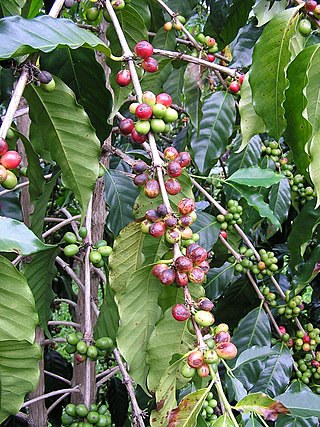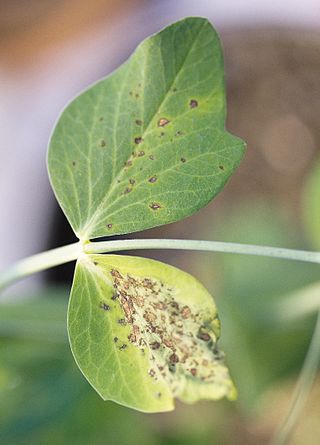
Black sigatoka is a leaf-spot disease of banana plants caused by the ascomycete fungus Mycosphaerella fijiensis (Morelet), also known as black leaf streak. It was discovered in 1963 and named for its similarities with yellow Sigatoka, which is caused by Mycosphaerella musicola (Mulder), which was itself named after the Sigatoka Valley in Fiji. In the same valley an outbreak of this disease reached epidemic proportions from 1912 to 1923.

Pseudocercosporella capsellae is a plant pathogen infecting crucifers. P. capsellae is the causal pathogen of white leaf spot disease, which is an economically significant disease in global agriculture. P. capsellae has a significant affect on crop yields on agricultural products, such as canola seed and rapeseed. Researchers are working hard to find effective methods of controlling this plant pathogen, using cultural control, genetic resistance, and chemical control practices. Due to its rapidly changing genome, P. capsellae is a rapidly emerging plant pathogen that is beginning to spread globally and affect farmers around the world.

Erysiphe betae is a fungal plant pathogen. It is a form of powdery mildew that can affect crops of sugar beet, that could cause up to a 30% yield loss. The fungus occurs worldwide in all regions where sugar beet is grown and it also infects other edible crops, e.g. beetroot.

Mycosphaerella brassicicola is a plant pathogen. The pathogen is the teleomorph phase of an ascomycete fungus, which causes the ring spot disease of brassicas. The supplementary anamorph phase Asteromella brassicae produces conidia through its asexual reproduction, however these spores are not confirmed to cause disease in host plants.

Mycosphaerella coffeicola is a sexually reproducing fungal plant pathogen. It is most commonly referred to as the asexual organism Cercospora coffeicola.

Zymoseptoria tritici, synonyms Septoria tritici, Mycosphaerella graminicola, is a species of filamentous fungus, an ascomycete in the family Mycosphaerellaceae. It is a wheat plant pathogen causing septoria leaf blotch that is difficult to control due to resistance to multiple fungicides. The pathogen today causes one of the most important diseases of wheat.

Podosphaera pannosa is a plant pathogen. It produces a powdery mildew on members of the rose family.

Ascochyta is a genus of ascomycete fungi, containing several species that are pathogenic to plants, particularly cereal crops. The taxonomy of this genus is still incomplete. The genus was first described in 1830 by Marie-Anne Libert, who regarded the spores as minute asci and the cell contents as spherical spores. Numerous revisions to the members of the genus and its description were made for the next several years. Species that are plant pathogenic on cereals include, A. hordei, A. graminea, A. sorghi, A. tritici. Symptoms are usually elliptical spots that are initially chlorotic and later become a necrotic brown. Management includes fungicide applications and sanitation of diseased plant tissue debris.
Cercospora arachidicola is a fungal ascomycete plant pathogen that causes early leaf spot of peanut. Peanuts originated in South America and are cultivated globally in warm, temperate and tropical regions.

Cercospora beticola is a fungal plant pathogen which typically infects plants of the genus Beta, within the family of Chenopodiaceae. It is the cause of Cercospora leaf spot disease in sugar beets, spinach and swiss chard. Of these hosts, Cercospora leaf spot is the most economically impactful in sugar beets. Cercospora beticola is a deuteromycete fungus that reproduces using conidia. There is no teleomorph stage. C. beticola is a necrotrophic fungus that uses phytotoxins specifically Cercospora beticola toxin (CBT) to kill infected plants. CBT causes the leaf spot symptom and prevents root formation. Yield losses from Cercospora leaf spot are around 20 percent.
Mycosphaerella angulata is a fungal plant pathogen infecting muscadine grapes. This pathogen causes the common disease angular leaf spot. Mycosphaerella angulate is an ascomycete in the fungi kingdom.
Mycosphaerella henningsii is a fungal plant pathogen that causes Brown leaf spot (BLS) in cassava).Part

Ascochyta pisi is a fungal plant pathogen that causes ascochyta blight on pea, causing lesions of stems, leaves, and pods. These same symptoms can also be caused by Ascochyta pinodes, and the two fungi are not easily distinguishable.

Didymella bryoniae, syn. Mycosphaerella melonis, is an ascomycete fungal plant pathogen that causes gummy stem blight on the family Cucurbitaceae, which includes cantaloupe, cucumber, muskmelon and watermelon plants. The anamorph/asexual stage for this fungus is called Phoma cucurbitacearum. When this pathogen infects the fruit of cucurbits it is called black rot.
Mycosphaerella musicola is a fungal plant pathogen, which is the causal agent of Yellow Sigatoka leaf spot disease on banana plants.

Cercospora melongenae is a fungal plant pathogen that causes leaf spot on eggplant. It is a deuteromycete fungus that is primarily confined to eggplant species. Some other host species are Solanum aethiopicum and Solanum incanum. This plant pathogen only attacks leaves of eggplants and not the fruit. It is fairly common among the fungi that infect community gardens and home gardens of eggplant. Generally speaking, Cercospora melongenae attacks all local varieties of eggplants, but is most severe on the Philippine eggplant and less parasitic on a Siamese variety.

Grey leaf spot (GLS) is a foliar fungal disease that affects maize, also known as corn. GLS is considered one of the most significant yield-limiting diseases of corn worldwide. There are two fungal pathogens that cause GLS: Cercospora zeae-maydis and Cercospora zeina. Symptoms seen on corn include leaf lesions, discoloration (chlorosis), and foliar blight. Distinct symptoms of GLS are rectangular, brown to gray necrotic lesions that run parallel to the leaf, spanning the spaces between the secondary leaf veins. The fungus survives in the debris of topsoil and infects healthy crops via asexual spores called conidia. Environmental conditions that best suit infection and growth include moist, humid, and warm climates. Poor airflow, low sunlight, overcrowding, improper soil nutrient and irrigation management, and poor soil drainage can all contribute to the propagation of the disease. Management techniques include crop resistance, crop rotation, residue management, use of fungicides, and weed control. The purpose of disease management is to prevent the amount of secondary disease cycles as well as to protect leaf area from damage prior to grain formation. Corn grey leaf spot is an important disease of corn production in the United States, economically significant throughout the Midwest and Mid-Atlantic regions. However, it is also prevalent in Africa, Central America, China, Europe, India, Mexico, the Philippines, northern South America, and Southeast Asia. The teleomorph of Cercospora zeae-maydis is assumed to be Mycosphaerella sp.

Ascochyta blights occur throughout the world and can be of significant economic importance. Three fungi contribute to the ascochyta blight disease complex of pea. Ascochyta pinodes causes Mycosphaerella blight. Ascochyta pinodella causes Ascochyta foot rot, and Ascochyta pisi causes Ascochyta blight and pod spot. Of the three fungi, Ascochyta pinodes is of the most importance. These diseases are conducive under wet and humid conditions and can cause a yield loss of up to fifty percent if left uncontrolled. The best method to control ascochyta blights of pea is to reduce the amount of primary inoculum through sanitation, crop-rotation, and altering the sowing date. Other methods—chemical control, biological control, and development of resistant varieties—may also be used to effectively control ascochyta diseases.
Raspberry leaf spot is a plant disease caused by Sphaerulina rubi, an ascomycete fungus. Early symptoms of infection are dark green spots on young leaves. As the disease progresses, these spots turn tan or gray in color. Disease management strategies for raspberry leaf spots include the use of genetically resistant raspberry plant varieties, chemical fungicide sprays, and cultural practices such as pruning and thinning out canes.

Common spot of strawberry is one of the most common and widespread diseases afflicting the strawberry. Common spot of strawberry is caused by the fungus Mycosphaerella fragariae. Symptoms of this disease first appear as circular, dark purple spots on the leaf surface. Mycosphaerella fragariae is very host-specific and only infects strawberry.
[1] Lin, Y., Yang, Z., Guo, Z. (1995). An Overview for Taiwan Farmers. P188. ISBN:9910000000027(林益昇、楊佐琦、郭章信。1995。台灣農家要覽農作篇(三),第188頁。葉瑩編。)
[2] Sivanesan, A. (1990). Mycosphaerella cruenta. [Descriptions of Fungi and Bacteria]. IMI Descriptions of Fungi and Bacteria, (99)
[3] Boa, E., (2014) Cercospora leaf spot of cowpea. http://africasoilhealth.cabi.org/wpcms/wp-content/uploads/2015/02/38-legumes-cercospora-leaf-spot.pdf
[4] Cowpea cercospora leaf spot. Website for China agricultural information (中国农业信息网) http://www.agri.cn/kj/syjs/zzjs/201608/t20160812_5237278.htm
[6] Cercospora cruenta Sacc. 1880. Encyclopedia of Life. https://eol.org/pages/51119821/articles
[7] Cowpea. Penn State University. https://plantvillage.psu.edu/topics/cowpea/infos
[8] Cowpea Cercospora leaf spot. Pacific Pests and Pathogens - Fact Sheets. http://www.pestnet.org/fact_sheets/cowpea_cercospora_leaf_spot_303.htm














